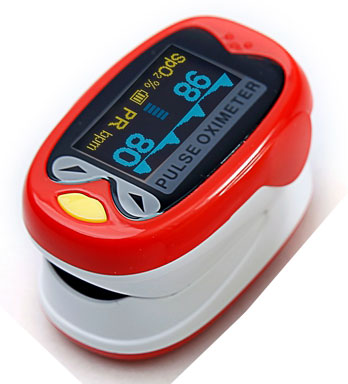Introduction to Fingertip Pulse Oximeters
In today's health-conscious world, the demand for devices that help in monitoring vital signs is ever-growing. Among them, the Fingertip Pulse Oximeter has emerged as an essential tool for both medical professionals and individuals seeking to keep track of their respiratory and cardiovascular health. This small, portable device measures the oxygen saturation level in your blood, offering valuable insights into your overall health. But why should you choose a Fingertip Pulse Oximeter over other health monitoring tools? This article aims to explore the multifaceted benefits and uses of this device, delving into its accuracy, practical applications, and the available options in the market, including Custom Fingertip Pulse Oximeters, ODM Fingertip Pulse Oximeters, and OEM Fingertip Pulse Oximeters.
Benefits of Using a Fingertip Pulse Oximeter
● Noninvasive and Painless
One of the most significant advantages of a Fingertip Pulse Oximeter is its noninvasive nature. Unlike traditional methods of assessing blood oxygen levels that require blood samples, this device offers a painless and rapid assessment. By simply clipping the device onto your finger, you can instantly receive critical information about your oxygen saturation levels and pulse rate.
● Provides Immediate Results
Speed is of the essence in many medical scenarios. The Fingertip Pulse Oximeter provides real-time readings, making it an invaluable tool in emergency situations. Whether you're a healthcare provider needing quick insights into a patient's condition or someone monitoring health conditions like asthma or COPD at home, the immediate results facilitate timely decision-making and interventions.
Who Should Use a Pulse Oximeter?
● Patients with Respiratory or Cardiovascular Conditions
For individuals suffering from respiratory or cardiovascular issues, regular monitoring of blood oxygen levels is crucial. Conditions such as chronic obstructive pulmonary disease (COPD), asthma, pneumonia, and heart failure can significantly affect blood oxygen levels. A Fingertip Pulse Oximeter offers a convenient way for patients and caregivers to keep track of these levels and respond proactively to any changes.
● Home Monitoring for At-Risk Individuals
Beyond those with diagnosed conditions, people at risk of respiratory or cardiovascular issues can benefit from having a Fingertip Pulse Oximeter at home. It provides peace of mind by allowing for easy monitoring during exercise, sleep, or when experiencing symptoms like shortness of breath. The wide availability of Wholesale Fingertip Pulse Oximeters means that they are accessible to a broad audience.
How Pulse Oximeters Work
● The Science Behind Oxygen Level Measurement
The fundamental principle of a Fingertip Pulse Oximeter is the measurement of light absorption by hemoglobin in the blood. The device uses light-emitting diodes (LEDs) to send light through your finger. By analyzing the changes in light absorption between oxygenated and deoxygenated blood, the oximeter calculates your blood oxygen saturation level (SpO2) and pulse rate.
● Understanding Light Absorption and Blood Saturation
The accuracy of a Fingertip Pulse Oximeter lies in its ability to detect variations in light absorption. The device calculates the ratio of absorbed red and infrared light, translating it into an SpO2 percentage. This innovative technology allows for quick and reliable readings, making it an essential tool for healthcare practitioners and home users alike.
Accuracy and Limitations of Oximeters
● Factors Affecting Accuracy
While Fingertip Pulse Oximeters are generally accurate, several factors can influence their readings. Skin pigmentation, nail polish, and movement during measurement are known to affect results. Manufacturers, including Fingertip Pulse Oximeter suppliers and factories, continuously strive to optimize device accuracy by addressing these factors.
● Addressing Racial Bias in Readings
Recent studies have highlighted potential discrepancies in oximeter readings among different skin tones. Efforts are underway by Fingertip Pulse Oximeter manufacturers to improve algorithmic accuracy and ensure devices are inclusive. This commitment to equality ensures that everyone benefits from reliable health monitoring.
Practical Uses in Medical Settings
● Monitoring During Surgeries
In medical settings, the Fingertip Pulse Oximeter is an invaluable tool during surgeries. Anesthesiologists use it to monitor patients' oxygen levels, ensuring they remain within safe parameters throughout the procedure. This real-time monitoring helps in preventing complications and provides an extra layer of safety.
● Assessing the Effectiveness of Treatments
Medical professionals rely on oximeters to evaluate the effectiveness of various treatments, such as supplemental oxygen therapy or ventilator support. By providing immediate feedback, the device allows healthcare providers to adjust treatments as needed, enhancing patient care and outcomes.
Choosing the Right Pulse Oximeter
● Key Features to Consider
When selecting a Fingertip Pulse Oximeter, several factors should be taken into account, including accuracy, ease of use, and display clarity. Custom Fingertip Pulse Oximeters and OEM Fingertip Pulse Oximeters offer tailored options for specific needs, allowing users to choose the device best suited for their circumstances.
● Recommendations for Reliable Models
Several models on the market stand out for their reliability and accuracy. When purchasing, consider factors such as battery life, durability, and additional features like Bluetooth connectivity for data tracking. Engaging with reputable Fingertip Pulse Oximeter suppliers ensures that you invest in a quality product that meets your monitoring needs.
How to Properly Use a Pulse Oximeter
● Steps for Accurate Readings
To obtain accurate readings with a Fingertip Pulse Oximeter, follow these steps:
1. Ensure your hand is warm and relaxed.
2. Remove any nail polish or artificial nails.
3. Place the device on your finger, ensuring proper alignment.
4. Stay still and breathe normally during measurement.
5. Wait for a stable reading before recording the results.
● Common Mistakes to Avoid
Avoid common pitfalls such as using the device on cold fingers or in bright sunlight, as these can skew results. Adhering to manufacturer guidelines provided by Fingertip Pulse Oximeter factories will help you achieve the most reliable readings.
Interpreting Pulse Oximeter Readings
● Understanding Normal and Abnormal Levels
Normal blood oxygen saturation levels typically range from 95% to 100%. Levels consistently below 92% may indicate hypoxemia, a condition that requires medical attention. By regularly measuring with a Fingertip Pulse Oximeter, users can monitor trends in their oxygen levels and seek medical advice when necessary.
● When to Consult a Healthcare Professional
While a Fingertip Pulse Oximeter provides valuable insights, it is not a substitute for professional medical evaluation. Any persistent abnormal readings or symptoms should prompt a consultation with a healthcare provider to address underlying issues and adjust treatments accordingly.
Conclusion: The Value of Pulse Oximeters in Health
In summary, the Fingertip Pulse Oximeter stands as a crucial tool for health monitoring, offering a noninvasive, rapid, and reliable way to track blood oxygen levels. Whether used in medical facilities or at home, its applications are vast, and its benefits are immense. The availability of options such as ODM Fingertip Pulse Oximeters and Wholesale Fingertip Pulse Oximeters ensures that users can find devices tailored to their specific needs. As technology advances, the accuracy and applications of pulse oximetry are set to expand further, contributing to improved health outcomes and patient care.
Introducing Leis
Leis is a leading and fast-growing medical supplier devoted to the research, design, development, and manufacture of high-quality medical devices. With a rich, experienced team, Leis provides exceptional products and services to families and hospitals. Our offerings include home-care medical instruments, diagnostic equipment, and disposable medical consumables. Certified by ISO13485 and adhering to the "Quality First" principle, Leis stands as a trusted Fingertip Pulse Oximeter manufacturer, committed to customer satisfaction and continuous improvement.

